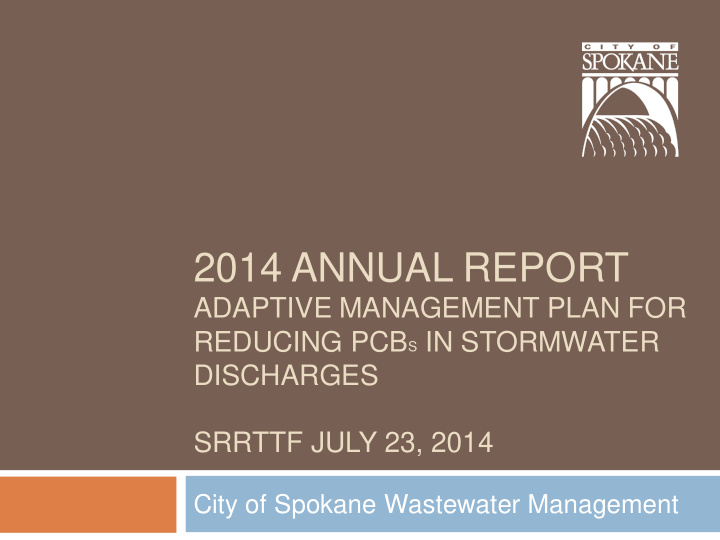



2014 ANNUAL REPORT ADAPTIVE MANAGEMENT PLAN FOR REDUCING PCB S IN STORMWATER DISCHARGES SRRTTF JULY 23, 2014 City of Spokane Wastewater Management
Study Area 2
Stormwater Management in Spokane 3 Pathway for PCBs to enter the Spokane River MS4: Municipal Separate Storm Sewer System CSO: Combined Primary PCB Sewer Overflow Sample (less frequent) Locations
Adaptive Management Plan 4 Reduce PCBs in stormwater and CSO discharges Analyze and interpret existing data 1) Identify likely sources of PCBs. 2) Design and implement remedial actions and BMPs. Adaptive approach – further data collection 3) and remedial action
Catch Basin Investigation Areas 5 2012 Re- Sample
2010 and 2011 Catch Basin Sampling 6 Highest in Heavy Industri al Zone = Re- sample in 2012
2012 Catch Basin Sampling 7
Remedial Maintenance 8 Review Aroclor analysis results Residential cleanup standard: 1.0 mg/kg Remove all sediments from catch basins Dump on separate pad, mix with sawdust Haul to lined cell at landfill
Curb Markers 9 Install markers at each basin after cleaning Installation in progress throughout City on normal maintenance routes • Over 7,000 Installed
2010 – 2012 Sampling Recap 10 2010 - 2012 Catch Basin Samples • 765 Catch Basins – broken into 76 Groups + individual basin re-samples • 590,000 lbs sediments removed • 32.4 grams PCBs removed Individual Samples • Helped identify contaminated CB near City Parcel • Disconnected from MS4 • PCBs still found in CBs after thorough cleaning in 2010 = continual PCB source in area • Average ~ 30% reduction in re-sampled CBs • Multiple older industrial sources: wind-blown and track-off • Ecology re-evaluating City Parcel site to investigate residual contamination off property
Stormwater Sampling: 2012- 2014 11
Stormwater Sampling Automatic composite samplers Depth Flow Rate Sample s
Stormwater Sampling 13 140,000 Legend 120,000 Maximum Third Quartile Near PCB Median Cleanup Site 100,000 First Quartile PCB Concentration (pg/L) Minimum 80,000 Heavy Industrial 60,000 Commercial 40,000 “Average” City stormwater 20,000 Liberty Lake Study, urban stormwater "background" 0 Union Outfall Union near City Parcel Cochran Washington CSO 34 CSO 06
Monthly Average Wind Speed Cochran Correlations CSO 34 Union @ City Parcel Washington CSO 06 Union Outfall 140,000 14 14 April 2013 windiest month since SRRTTF 2/1999; 120,000 12 Aerial Temperature Apr-13 Deposition inversion trapped Feb-14 Temperature Mar-14 Apr-14 wood smoke near 100,000 10 Study inversion trapped ground surface Wind Speed (mph) Total PCBs (pg/L) wood smoke near ground surface Mar-13 Sep-13 Dec-12 80,000 Oct-12 8 Nov-12 Jun-13 Nov-13 Jan-14 May-13 Jul-13 Feb-13 60,000 6 Aug-13 Sep-12 Dec-13 8/25 Large dust storm Oct-13 from Columbia Basin; Jan-13 wind at SIA 62 mph 40,000 4 Dry, windy "First flush" storm Spring 20,000 2 0 0 9/1/12 10/31/12 12/31/12 3/1/13 5/1/13 7/1/13 8/30/13 10/30/13 12/29/13 2/28/14 4/30/14
Union Basin Disconnection 15 PCBs ubiquitous Sources too numerous to track down individually Solution: treat and infiltrate stormwater San Francisco Estuary Institute BMP Toolbox for reducing PCBs in stormwater Tree Box Filter Vegetated Swale Image from www.filterra.com
Product Sampling 16 PCBs are still incidentally produced in manufacturing processes. City is sampling products in summer 2014: • Road paint: Yellow and • Diesel and gasoline • Dust suppressant white • Liquid and dried • Antifreeze • Thermoplastic tape • Lubricant • Hydrant Paint (Aluminum) • Asphalt sealer • Utility locate paint (green) • Crack sealer • Firefighting foam • Asphalt release agent • Deicer • Hydroseed • Vehicle wash soap • PVC pipe • Pesticide/herbicide • CIPP liner and Shortliner • Motor oil (new and used)
Product Sampling 17 Backup Samples • DEF • Windshield fluid • Brake Fluid • Vehicle wax • Hydraulic Fluid • Motor oil (other brands) • Utility locate paint (other) Additional wastewater-related samples • Hand soap • Laundry soap • Dish soap • Shampoo • Toothpaste
Decant Facility 18
Ordinance (SMC 7.06.172) 19 City shall provide preference for products and packaging that do not contain PCBs No City department may knowingly purchase products containing PCBs above the PQL unless it is not cost-effective (increasing the purchase price more than 25%) or feasible to do so. PQL = practical quantification limit, the lowest concentration that can be reliably measured using EPA 1668 Testing results may be requested from suppliers Ordinance effective 7/16/2014
Conclusions 20 • Individual sources difficult to identify • Widespread, diffuse source of PCBs Legacy sources from historic industrial activity PCBs found in everyday items (motor oil, hydraulic fluid, etc.) • Designing treatment and infiltration in Union basin (disconnect MS4 from river) • Integrated Clean Water Plan • Treat and infiltrate Cochran basin stormwater (and others) • CSO controls installed by 2017 • NLT operating year-round
Recommend
More recommend